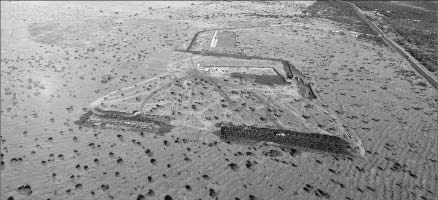In a sector dominated by old-school majors with ever-deepening mines, Platinum Group Metals (PTM-V, PLG-X) stands out as being anything but.
The decade-old Vancouver-based junior is now building a relatively shallow platinum-palladium-rhodium-gold (or “4E”) mine on the northwest tip of South Africa’s prolific Western Bushveld, home to 70% of the world’s platinum production.
The company has elbowed its way into a space controlled by
the likes of Anglo Platinum (AMS-J), Impala Platinum (IMP-L), Lonmin (LOM-L) and fellow Canadian junior Eastern Platinum (ELR-T).
Platinum Group Metals is developing its 74%-owned Western Bushveld joint venture (JV) Project 1 on the complex, with initial production expected in 2013. Site infrastructure and decline construction are already underway as part of an initial US$100 million budget for Project 1, paid for by a $125-million equity financing it completed last October at $2.05 per share.
Overall the company plans to finance the US$443 million in capital costs with roughly 60% debt and 40% equity, leaving US$266 million in debt to be worked out this year and its 74% share of US$77 million in equity remaining to be funded.
The company will be tapping into proven and probable reserves on the Merensky Reef of 18 million tonnes grading 5.51 grams 4E per tonne for 3.2 million oz. On the lower-grade UG2 Reef, the company has a further 13.5 million proven and probable tonnes grading 3.4 grams 4E for 1.5 million oz. 4E.
Once fully operational, Platinum Group expects to produce 200,000 oz. of platinum and palladium a year or 275,000 oz. 4E.
The Platinum Group Metals mine stands out on the Merensky Reef because most mines on the reef have been operational for a longer time. Companies dig deeper and deeper as a result, with most pushing past 1,000 metres depth to keep producing. Project 1, meanwhile, will be mined at around 300 metres depth.
“This is really the last big piece of Merensky Reef under 1,200 metres,” said company president and CEO R. Michael Jones at a recent investor presentation.
The shallower reefs make for cheaper mining, with life-of-mine average cost coming in at US$526 per oz. 4E, using 8 rand to the U.S. dollar. Close by, Impala Platinum’s #20 Shaft, mining at more than 1,000 metres deep, produces 4E at US$853 per oz.
A 2009 feasibility-study update projected that, on an after-tax basis, Project 1 has a net present value of US$583 million with a 5% discount rate, and an internal rate of return of 18.94%.
The study was based on the 8-to-1 exchange rate, plus US$1,343 per oz. platinum and US$322 per oz. palladium. Current platinum prices, however, are hovering around US$1,780 per oz. and
palladium prices around US$750 per oz.
Jones sees prices staying high, since production has largely stagnated while demand, driven by car sales and a total lack of substitutes, increases.
Platinum plummeted from a high of over US$2,200 per oz. in early 2008 to a low of US$800 per oz. by November of that year, closely following a plunge in global auto sales.
But despite the rebound in platinum prices, and Platinum Group Metals’ progress towards opening a major precious metals mine next year, the company’s stock has not rebounded along with platinum. Currently trading at around $2 with 177.5 million shares out for a $355-million market capitalization, Jones argued that the share value is far less than the company’s net asset value and the market is under-appreciating what will be a more than 200,000 oz. per year producing mine.
“This would be a spectacular Canadian gold mine,” Jones said.
The problem is South Africa, with its steady background chatter of nationalization, electricity issues, the sometimes-unclear Black Economic Empowerment legislation, recent violent labour protests at Eastern Platinum’s Crocodile mine, and Lonmin’s firing of 9,000 workers at its Karee mine after a strike.
Jones said the problems are overblown, and the company has worked diligently to ensure they do not affect future operations. Platinum Group has its empowerment issues resolved with Wesizwe Platinum holding 26% ownership, it has a long-term power guarantee with the state provider and, while it currently uses mostly contract labour, it is already proactive in community and labour relations.
As to nationalization, Jones said that elected officials and unions are against it, concluding that “the whole idea is less than half-baked.”
Going forward in 2011, the company will continue to develop the WBJV Project 1 as it looks to secure bank financing and continue with permitting. But with many high-profile acquisitions and takeovers on the Bushveld recently, Jones is not ruling out selling.
“We’re open to a deal on the company, and we’re also prepared to drive the project forward,” Jones said. “When I say all options are open to realize shareholder value, I mean it.”
Jones has had experience making such decisions before. As co-founder of both MAG Silver (MAG-T) and West Timmins Mining (with Platinum Group’s CFO Frank Hallam), he helped make the call that for West Timmins it was the right time to sell and for MAG Silver, which has doubled in price since it received a bid, it was not.
Platinum Group Metals’ other assets include the 2 million indicated oz. 4E Project 3 near Project 1, earlier-stage projects on the North Limb of the Bushveld Complex, and exploration projects in northern Ontario.


Be the first to comment on "Platinum Group Metals pushing forward on Western Bushveld (June 06, 2011)"